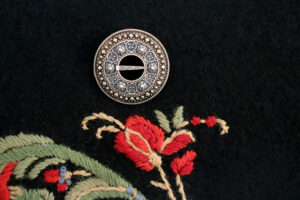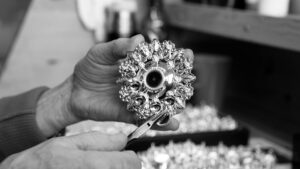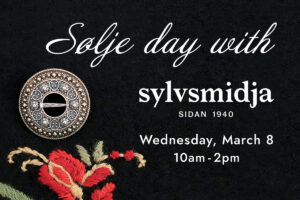Sylvsmidja has been crafting bunad silver for over 80 years. They specialize in traditional craftsmanship and quality to last generations, making each piece an heirloom. This family business is now the world’s largest producer of Sølje.

History of the company
Anne Kari Johannessen, co-owner, is the third generation of the Johannessen family to manage Sylvsmidja. Today they have 63 employees, making them one of the largest businesses and employers in Voss.

Leif Johannessen made an unexpected career choice to become a goldsmith in the early 1900s. Unlike his family and friends who worked as fisherman and sailors, he traveled to Oslo to train in the gold and silver trade. World War I forced Leif to Bergen, where he opened his own workshop – only 6 days after graduating school! He continued his career by teaching and traveling to train and continue his own education. His reputation grew in Bergen and he was commissioned to make the christening gift, on behalf of the city of Bergen, for the child who is now King Harald V of Norway.
After establishing himself and his family in Bergen, World War II was imminent. The family didn’t feel safe in the city and took refuge by moving to the countryside, to Voss. In a tragic turn of events, Voss was one of the Norwegian cities hit hardest by the war, with 150 homes bombed to the ground. Somehow, through all the destruction, Leif got access to a storefront and with help from the community, opened up his workshop as “Sylvsmidja” in December 1940. A very clever businessman, Leif garnered a reputation and fixed tools and horse bridles, made metal screws and crafted knitting pins for the local women. This work carried the business through to the end of the war.
Leif’s sons worked for the company. Einar and Thorleif transformed the company from a small family business to a crafter with national acclaim. Their wives joined the fold and contributed their own talents to the business.

Registered Hallmark
Stamped on every product is a symbol of Sylvsmidja’s commitment to quality. It is an ancient drinking horn and it is also a “J” for the Johannessen family name. You will also find it within the S of the company logo. ![]()

Sølje Pieces
Sølje jewelry is much older than the bunad (Norway’s national dress). The word “Sølje” refers to the traditional brooch worn with a Norwegian bunad; the origin of the word is from the old Norse language “silja” and means “buckle.” The true origin of the word is still unknown, as it could have derived from Finnish or German, but ultimately means, “keeping clothes together.” According to Anne Kari, sølje is full of symbols and secrets, “none of its paths are randomly created.”
The designs are known for their symbolism and association with mythology. Each piece holds unique symmetry and numerical symbols. Everything is divisible by either three or four, representing the holy trinity and the four corners of the earth. These numbers reflect the gratitude and respect for creation in each piece. Motifs of human and animal faces are also common, similar to the embellishments found on Stave Churches. These forms are protection against evil spirits.
Sylsvmidja makes dozens of different designs but they still hold value in a simple and well made button. Anne Kari said, “The button does not only keep your shirt together, it keeps our cultural heritage together.”
Cleaning – How to clean your Sølje
Below is a general guide, from Sylvsmidja, on how to clean even the most intricate silver and gold pieces. You do not want to clean your Sølje too often, as it can wear down the finishes over time. Make sure you have an airtight way to store your Sølje between wears – this will cut down on the cleaning.
Step 1: Gather your materials
You will need a brush or cloth, liquid dish soap, water, two large bowls or vessels and one small, and a liquid silver cleaner. Create a vessel filled with soapy water, a vessel filled with plain water, and a smaller vessel for the cleaning fluid.
Step 2: Remove oil and dust
Using a soft haired brush (an unused toothbrush works well here), dip the piece into the soapy water, and lightly scrub to remove oil and dust. This process allows the cleaner to work more effectively on the clean metals.
Step 3: Water rinse
After the wash, dip the jewelry in the clean water bath to remove all soap.
Step 4: Cleaning dip
Prepare to dip the piece in the cleaning liquid, making sure to dip no more than 3 seconds. After the three seconds in the cleaner, stop the chemical process by dipping the piece back into the clean water bath. If the silver still has tarnish on it, you can repeat Step 4 up to three times to fully remove any tarnish or discoloring. Make sure to use the water bath between 3 second dips in the cleaning liquid.
Step 5: Final clean
To ensure all the chemicals are removed, dip the piece one last time in the soapy water and use the brush to lightly clean. Finish with a clean water rinse.
Step 6: Dry and store
Use a paper towel to completely dry the piece. Once you are sure that it is dry, store your Sølje in an airtight plastic bag. You can find more information on storage on the Sylvsmidja site here.
Other tips –
- If your piece is very old or antique, you will want to take it to a professional to clean
- Often the pieces you buy come with a plastic bag inside the box – keep this for storage!
- If you have an oxidized piece, you can still clean with the dip, but it is recommended to keep the time in the cleaner to a minimum to keep the patina (this finish is made to be more durable so cleaning may not be necessary, alternatively you can spot clean with a cloth)
- You can use a polishing cloth for spot cleaning on silver or oxidized silver, it is not recommended for gold or gold-plate
Anne Kari & Anders of Norwegian Silver producer, Sylvsmidja will be visiting for the day! Sylvsmidja is Norway’s premier maker of Sølje, traditional jewelry for national costumes.
Along with information on the history of the company and how to clean these intricate silver and gold pieces, they will be offering appointments throughout the day for evaluation of your personal Sølje jewelry. Find more information on our website.
We carry Sylvsmidja Sølje all year round, stop by and visit or shop Sølje online.

I purchased a small sølje pin when we visited Voss, Norway last September to give to my grandson and his wife for the baptism of their first child and my first great-grandchild. I was once told that there was a tradition to give the first sølje for the christening of the child. The child is a boy–I was told to have the child wear the pin for the baptism but to later pass it on and give it along with the larger pins for marriage to the child’s future bride. My question is: am I correct regarding the tradition or is the small pin only for a girl child at their christening? Thanks for the prompt response since the baptism is on April 16. I purchased the pin at a corner store in Voss that had jewelry and bunads with a troll figure at the entrance of the store. We stayed at Fleischer’s Hotel in Voss and had a wonderful time visiting our heritage farms. We live in Sioux Falls, SD.
Hi Dennis, thanks for sharing your story with us! Traditionally, children are given a smaller brooch for their baptism or christening, of any gender. Sometimes a larger pin is given when a girl becomes a woman and then a more ornate one as a wedding gift for the bride. Grooms also wear Sølje in traditional Norwegian weddings. The smaller brooch is then given to the next child in the new generation. The rules are up for interpretation and you can of course, start a new tradition within your family. The basis of the gift is to keep away evil spirits throughout one’s life. Hope this helps!